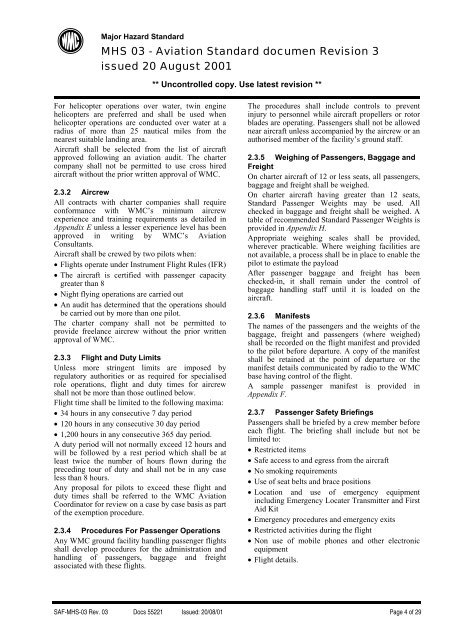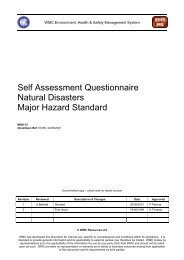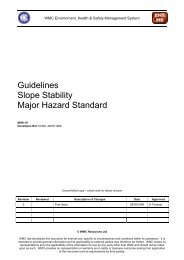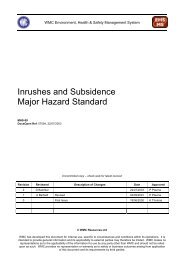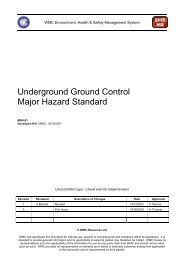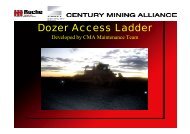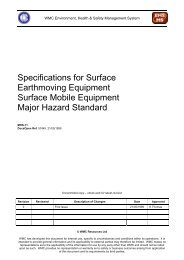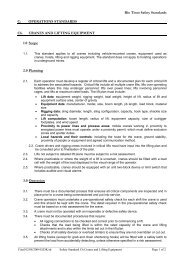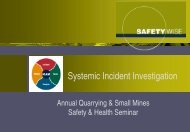Aviation Major Hazard Standard - MIRMgate
Aviation Major Hazard Standard - MIRMgate
Aviation Major Hazard Standard - MIRMgate
You also want an ePaper? Increase the reach of your titles
YUMPU automatically turns print PDFs into web optimized ePapers that Google loves.
<strong>Major</strong> <strong>Hazard</strong> <strong>Standard</strong><br />
MHS 03 - <strong>Aviation</strong> <strong>Standard</strong> documen Revision 3<br />
issued 20 August 2001<br />
** Uncontrolled copy. Use latest revision **<br />
For helicopter operations over water, twin engine<br />
helicopters are preferred and shall be used when<br />
helicopter operations are conducted over water at a<br />
radius of more than 25 nautical miles from the<br />
nearest suitable landing area.<br />
Aircraft shall be selected from the list of aircraft<br />
approved following an aviation audit. The charter<br />
company shall not be permitted to use cross hired<br />
aircraft without the prior written approval of WMC.<br />
2.3.2 Aircrew<br />
All contracts with charter companies shall require<br />
conformance with WMC’s minimum aircrew<br />
experience and training requirements as detailed in<br />
Appendix E unless a lesser experience level has been<br />
approved in writing by WMC’s <strong>Aviation</strong><br />
Consultants.<br />
Aircraft shall be crewed by two pilots when:<br />
• Flights operate under Instrument Flight Rules (IFR)<br />
• The aircraft is certified with passenger capacity<br />
greater than 8<br />
• Night flying operations are carried out<br />
• An audit has determined that the operations should<br />
be carried out by more than one pilot.<br />
The charter company shall not be permitted to<br />
provide freelance aircrew without the prior written<br />
approval of WMC.<br />
2.3.3 Flight and Duty Limits<br />
Unless more stringent limits are imposed by<br />
regulatory authorities or as required for specialised<br />
role operations, flight and duty times for aircrew<br />
shall not be more than those outlined below.<br />
Flight time shall be limited to the following maxima:<br />
• 34 hours in any consecutive 7 day period<br />
• 120 hours in any consecutive 30 day period<br />
• 1,200 hours in any consecutive 365 day period.<br />
A duty period will not normally exceed 12 hours and<br />
will be followed by a rest period which shall be at<br />
least twice the number of hours flown during the<br />
preceding tour of duty and shall not be in any case<br />
less than 8 hours.<br />
Any proposal for pilots to exceed these flight and<br />
duty times shall be referred to the WMC <strong>Aviation</strong><br />
Coordinator for review on a case by case basis as part<br />
of the exemption procedure.<br />
2.3.4 Procedures For Passenger Operations<br />
Any WMC ground facility handling passenger flights<br />
shall develop procedures for the administration and<br />
handling of passengers, baggage and freight<br />
associated with these flights.<br />
The procedures shall include controls to prevent<br />
injury to personnel while aircraft propellers or rotor<br />
blades are operating. Passengers shall not be allowed<br />
near aircraft unless accompanied by the aircrew or an<br />
authorised member of the facility’s ground staff.<br />
2.3.5 Weighing of Passengers, Baggage and<br />
Freight<br />
On charter aircraft of 12 or less seats, all passengers,<br />
baggage and freight shall be weighed.<br />
On charter aircraft having greater than 12 seats,<br />
<strong>Standard</strong> Passenger Weights may be used. All<br />
checked in baggage and freight shall be weighed. A<br />
table of recommended <strong>Standard</strong> Passenger Weights is<br />
provided in Appendix H.<br />
Appropriate weighing scales shall be provided,<br />
wherever practicable. Where weighing facilities are<br />
not available, a process shall be in place to enable the<br />
pilot to estimate the payload<br />
After passenger baggage and freight has been<br />
checked-in, it shall remain under the control of<br />
baggage handling staff until it is loaded on the<br />
aircraft.<br />
2.3.6 Manifests<br />
The names of the passengers and the weights of the<br />
baggage, freight and passengers (where weighed)<br />
shall be recorded on the flight manifest and provided<br />
to the pilot before departure. A copy of the manifest<br />
shall be retained at the point of departure or the<br />
manifest details communicated by radio to the WMC<br />
base having control of the flight.<br />
A sample passenger manifest is provided in<br />
Appendix F.<br />
2.3.7 Passenger Safety Briefings<br />
Passengers shall be briefed by a crew member before<br />
each flight. The briefing shall include but not be<br />
limited to:<br />
• Restricted items<br />
• Safe access to and egress from the aircraft<br />
• No smoking requirements<br />
• Use of seat belts and brace positions<br />
• Location and use of emergency equipment<br />
including Emergency Locater Transmitter and First<br />
Aid Kit<br />
• Emergency procedures and emergency exits<br />
• Restricted activities during the flight<br />
• Non use of mobile phones and other electronic<br />
equipment<br />
• Flight details.<br />
SAF-MHS-03 Rev. 03 Docs 55221 Issued: 20/08/01 Page 4 of 29


